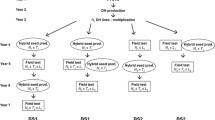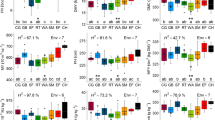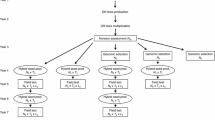Abstract
Optimum allocation of test resources is of crucial importance for the efficiency of breeding programs. Our objectives were to (1) determine the optimum allocation of the number of lines, test locations, as well as number and type of testers in hybrid maize breeding using doubled haploids with two breeding strategies for improvement of general combining ability (GCA), (2) compare the maximum selection gain (ΔG) achievable under both strategies, and (3) give recommendations for the optimum implementation of doubled haploids in commercial hybrid maize breeding. We calculated ΔG by numerical integration for two two-stage selection strategies with evaluation of (1) testcross performance in both stages (BS1) or (2) line per se performance in the first stage followed by testcross performance in the second stage (BS2). Different assumptions were made regarding the budget, variance components (VCs), and the correlation between line per se performance and GCA. Selection gain for GCA increased with a broader genetic base of the tester. Hence, testers combining a large number of divergent lines are advantageous. However, in applied breeding programs, the use of single- or double-cross testers in the first and inbred testers in the second selection stage may be a good compromise between theoretical and practical requirements. With a correlation between line per se performance and GCA of 0.50, ΔG for BS1 is about 5% higher than for BS2, if an economic weight of line per se performance is neglected. With increasing economic weight of line per se performance, relative efficiency of BS2 increased rapidly resulting in a superiority of BS2 over BS1 already for an economic weight for line per se performance larger than 0.1. Considering the importance of an economic seed production, an economic weight larger than 0.1 seems realistic indicating the necessity of separate breeding strategies for seed and pollen parent heterotic groups.

Similar content being viewed by others
References
Baker RJ (1986) Selection indices in plant breeding. CRC Press, Boca Raton, pp 97–108
Becker H (1993) Pflanzenzüchtung. (In German) Verlag Eugen Ulmer, Stuttgart, pp 129–132
Cochran WG (1951) Improvement by means of selection. In: Proc 2nd Berkeley Symp Math Stat Prob, pp 449–470
Federer WT, Sprague GF (1947) A comparison of variance components in corn yield trials: I. Error, tester × line, and line components in top-cross experiments. J Am Soc Agron 39:453–463
Finney DJ (1966) An experimental study of certain screening processes. J R Stat Soc B 28:88–109
Gallais A (1997) Combined testcross and S1 selection for the improvement of testcross and inbred performances. Crop Sci 37:1126–1133
Grüneberg WJ, Abidin E, Ndolo P, Pereira CA, Hermann M (2004) Variance component estimations and allocation of resources for breeding sweetpotato under East African conditions. Plant Breed 123:311–315
Hallauer AR, Miranda JB (1981) Quantitative genetics in maize breeding. Iowa State University Press, Ames, pp 267–298
Hallauer AR, Russell WA, Lamkey KR (1988) Corn breeding. In: Sprague GF, Dudley JW (eds) Corn and corn improvement, 3rd edn. Am Soc Agronomy, Madison, pp 463–564
Hanson WD, Brim CA (1963) Optimum allocation of test material for two-stage testing with an application to evaluation of soybean lines. Crop Sci 3:43–49
Keller KR (1949) A comparison involving the number of, and relationship between, testers in evaluating inbred lines of maize. Agron J 41:323–331
Longin CFH, Utz HF, Reif JC, Schipprack W, Melchinger AE (2006a) Hybrid maize breeding with doubled haploids: I. One-stage versus two-stage selection for testcross performance. Theor Appl Genet 112:903–912
Longin CFH, Utz HF, Melchinger AE, Reif JC (2006b) Hybrid maize breeding with doubled haploids: Comparison between selection criteria. Acta Agron Hung. DOI 10.1556/AAgr.54.2006.3
Melchinger AE, Longin CF, Utz HF, Reif JC (2005) Hybrid maize breeding with doubled haploid lines: quantitative genetic and selection theory for optimum allocation of resources. In: Proceedings of the 41st annual Illinois Corn Breeders’ School 2005, Urbana-Champaign, pp 8–21
Mihaljevic R, Schön CC, Utz HF, Melchinger AE (2005) Correlations and QTL correspondence between line per se and testcross performance for agronomic traits in four populations of European maize. Crop Sci 45:114–122
Schmidt W (2004) Hybridmaiszüchtung bei der KWS SAAT AG. (In German) In: Bericht über die 54. Tagung der Vereinigung der Pflanzenzüchter und Saatgutkaufleute Österreichs 2003, Gumpenstein, pp 1–6
Schnell FW (1996) Über Zuchtplanung und die Entscheidungsspielräume des Pflanzenzüchters (in German). Vorträge Pflanzenzüchtung 33:227–244
Schrag TA, Melchinger AE, Sørensen AP, Frisch M (2006) Prediction of single-cross hybrid performance for grain yield and grain dry matter content in maize using AFLP markers associated with QTL. Theor Appl Genet, in press
Seitz G (1989) Experimentelle und theoretische Untersuchungen zur Beziehung zwischen Linieneigenleistung und allgemeiner Kombinationsfähigkeit bei Silomais. (in German) PhD Thesis, University of Hohenheim, Stuttgart
Seitz G (2005) The use of doubled haploids in corn breeding. In: Proceedings of the 41st annual illinois corn Breeders’ School 2005, Urbana-Champaign, pp 1–7
Seitz G, Geiger HH, Schmidt GA, Melchinger AE (1992) Genotypic correlations in forage maize. II: relationship between inbred line and testcross performance. Maydica 37:101–105
Sprague GF, Federer WT (1951) A comparison of variance components in corn yield trials: II. Error, year × variety, location × variety and variety components. Agron J 42:535–541
Tomerius AM (2001) Optimizing the development of seed-parent lines in hybrid rye breeding. PhD Thesis, University of Hohenheim (http://opus-ho.uni-stuttgart.de/hop/volltexte/2001/10/pdf/tomerius.pdf)
Utz HF (1969) Mehrstufenselektion in der Pflanzenzüchtung. (In German) Arbeiten der Universität Hohenheim, vol 49, Verlag Eugen Ulmer, Stuttgart
Weiss KMR (1981) Beziehungen zwischen Linienleistung, Heterosis und Hybridleistung bei Mais. PhD Thesis, University of Hohenheim
Acknowledgments
This research was supported by funds from DFG, grant no. 1070/1, International Research Training Group “Sustainable Resource Use in North China” to C. F. H. Longin. The authors appreciate the editorial work of Dr. J. Muminović, whose suggestions considerably improved the style of the manuscript. In addition, the authors thank Dr. G. Seitz, AgReliant Genetics, Westfield, IN, USA and Dr. W. Schipprack, Institute of Plant Breeding, Seed Science, and Population Genetics, University of Hohenheim, Stuttgart, Germany for their valuable suggestions We greatly appreciate the helpful comments and suggestions of two anonymous reviewers.
Author information
Authors and Affiliations
Corresponding author
Additional information
Communicated by H. C. Becker.
C. Friedrich H. Longin and H. Friedrich Utz have contributed equally to this work.
Rights and permissions
About this article
Cite this article
Longin, C.F.H., Utz, H.F., Melchinger, A.E. et al. Hybrid maize breeding with doubled haploids: II. Optimum type and number of testers in two-stage selection for general combining ability. Theor Appl Genet 114, 393–402 (2007). https://doi.org/10.1007/s00122-006-0422-z
Received:
Accepted:
Published:
Issue Date:
DOI: https://doi.org/10.1007/s00122-006-0422-z




